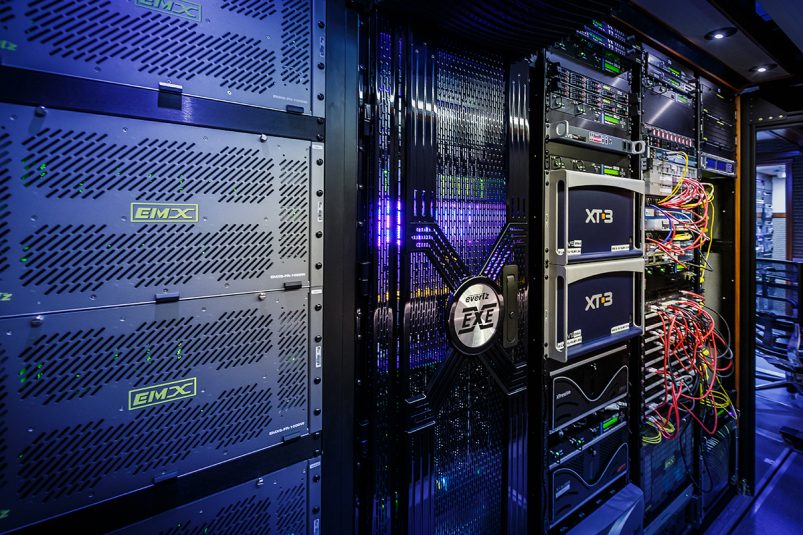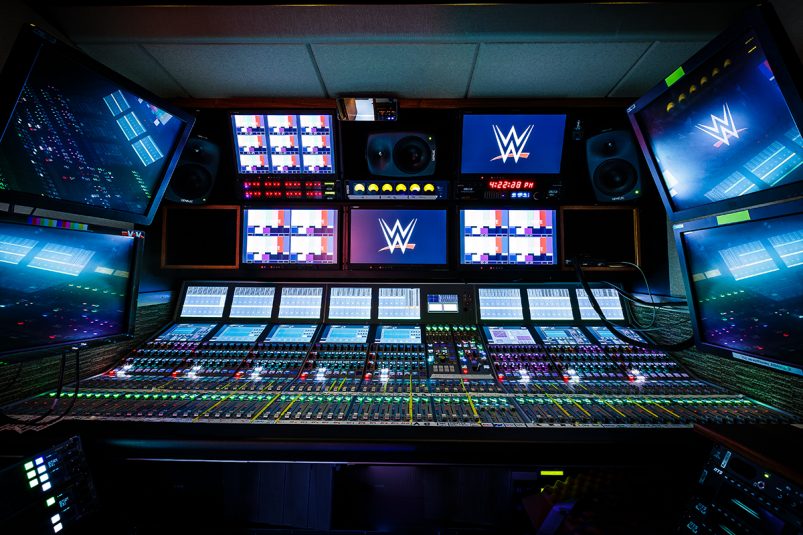WWE Embraces IP, Expands Footprint With New Trio of NEP Trucks
WWE's new trucks feature an IP router, plenty of tech firepower, and much larger footprint than its previous Red and Black NEP mobile units.
Story Highlights
When it comes to live remote television production, schedules don’t get more packed than WWE. Fifty-two weeks a year, its team produces a live event on Mondays (Raw on USA) and a taped event on Tuesdays (Smackdown on USA, which will be broadcast live beginning July 19), as well as a dozen PPV events per year (including the Super Bowl-size WrestleMania). Throw in the ever growing content needs of the burgeoning WWE Network, and it’s easy to see why WWE had outgrown its NEP Red and Black mobile units and opted to roll out a trio of state-of-the-art NEP production trucks last month.
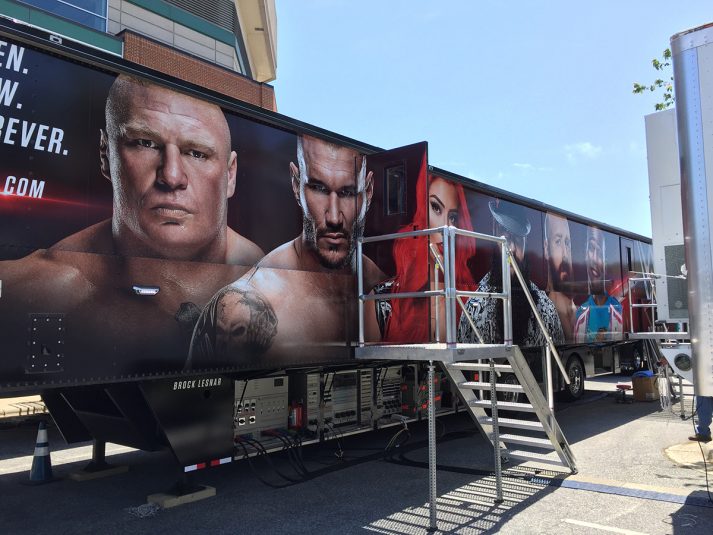
WWE new mobile unit features a significantly larger footprint with two double expandos and a supporting C unit.
“It’s very exciting, and it’s very rewarding to have these new platforms. We knew that we had maxed out Red and Black and needed to expand. Now we can give production the professional workspace and technical firepower that they deserve,” says Duncan Leslie, SVP, event technical operations, WWE. “It was a very organic build and a real team effort between WWE staff, NEP, freelancers, and vendors from start to finish because of the complexity involved. That allowed a pretty seamless transition and some brand-new systems to be introduced.”
WWE 1, 2, and 3 — the third set of WWE mobile units built by NEP since 2001 — are built around an Evertz EXE IP router, a Grass Valley Kayenne K-Frame switcher (192 inputs, 9M/E, two control panels), a 40-GBps fiber backbone, and Dante IP-based audio/comms. The trio also boasts a massive footprint, with two double expandos and a C unit, that houses two control rooms and four audio-mixing rooms. The trucks roll with three Sony HDC-4300 cameras operating at 240 fps (4X slo-mo) and a battalion of Sony HDC-2500s (set to be upgraded to HDC-4300s at some point this year) — all outfitted with new Canon lenses.
“The big question was IP or no IP. Ultimately, we decided to go with [an IP router],” says Mike Grossman, SVP, television operations, WWE. “IP allowed expansion for larger shows and different types of shows, and we also understood that was the way of the future. There are always challenges when embracing any new technology, but, in this case, those decision were obviously correct. The IP routing scheme and adoption of Dante audio have been a real sea change for us.”
Gigantic PPV Events, Non-Stop Schedule, Digital Network Need Complex Trucks
Much of the need for a new mobile unit centered on the gargantuan needs of WrestleMania, which has become one of the largest annual live events in the U.S. and demands a growing arsenal of production resources. In addition to the PPV linear telecast and WWE network live-streamed content, WWE’s trucks drive the massive videoboard show at the venue.
“The overall WrestleMania scope has grown outside of just one show; it’s now a number of shows across the region where it is held, and they are managing dozens of inbound and outbound [feeds],” says Glen Levine, co-president, U.S. Mobile Units, NEP. “So the trucks started to explode at the seams over the past couple years, and the infrastructure just wasn’t supporting it. After lots of discussion, it became apparent that there were better-streamlined ways to do things for future growth with an IP router.”
However, at the same time, WWE’s non-stop schedule necessitated a seamless transition for the production team — meaning that the new trucks had to look and feel like the Red and Black, with significantly beefed-up backend technology.
“The WWE does an awful lot of television shows throughout the year,” notes Levine. “They don’t like change because they’re a very well-oiled machine:. They go into venues in the morning, do massive productions, and then get out in the evening and go to another city. So, from a production standpoint, they were looking for minimal change. There was a lot of focus on keeping things very similar for the producer and the director but still adding to the areas that were in need of expansion, especially graphics and replay, which have become a big part of their show.”
On top of all that, the domestic and international growth of WWE Network, the 2½-year-old subscription-based streaming service, has drastically increased WWE’s production needs both onsite at events and at its broadcast center in Stamford, CT.
“WWE Network had a big impact on [the truck design],” says Grossman. “The network requires a pretty significant amount of shoulder programming, and we also had to expand our production capabilities in terms of multi-languaging. We’re even expanding what we do with our core product as well as all these other ancillary shows we’re adding. The new trucks have helped us accommodate a lot of that.”
Jumping Aboard the IP and Tapeless Bandwagon
WWE’s trucks, which debuted April 25, mark NEP’s third unit to feature an IP router, following SSCBS and SS24. In addition to the Evertz EXE IP router, WWE relies on a 100%-fiber infrastructure throughout the trucks and into each venue (all copper has been eliminated) and Dante-based IP audio and comms. The unit features a 40-Gbps infrastructure within the trucks and 10-Gbps connectivity to drops throughout the venue. In addition, WWE leverages an enterprise-class Cisco network throughout the trucks, allowing the IT team to more easily integrate with each venue and manage the massive event that WWE delivers on top of the linear telecast.
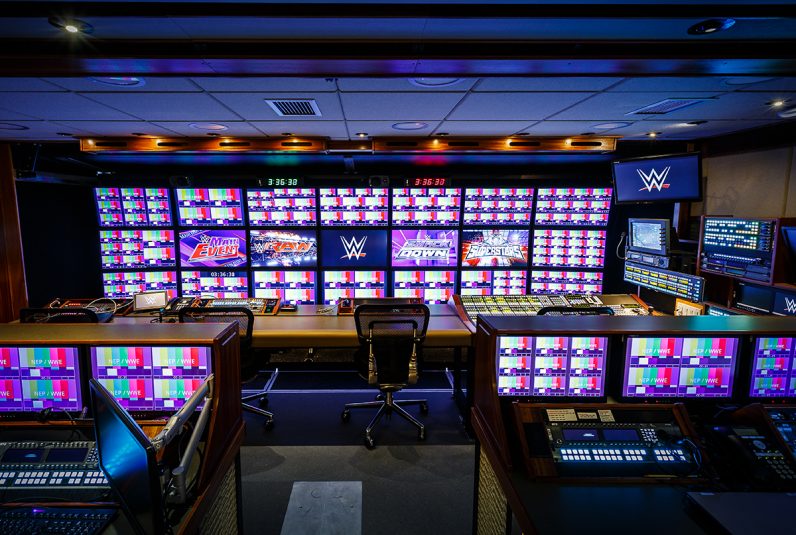
NEP and WWE worked to make the primary control room as ergonomically similar to the previous truck’s as possible.
“The IP router allowed us to put a lot of that router I/O remote and go right out of the router at each of these locations whether it be in the trucks or spread out into the venue,” says Joe Signorino, VP, systems integration, NEP. “You eliminate a lot of that baseband-to-fiber conversion and back to baseband at the other end, leaving quite a bit of flexibility. Things aren’t in the same location in every venue, so the way the fiber system was laid out left them a lot of flexibility to connect all these different workstations and things to one of two places in the venue.”
With the lack of a true IP standard today, he says, the trucks will be able to adapt to whichever IP standard wins out in the future. In addition, although the equipment is not currently available for a purely IP ecosystem within the truck, he is confident this reality is not far off.
“In the future, as equipment starts to show up that actually has some IP connectivity on it, you will see this [truck] continue to evolve,” says Signorino. “At this point, you still are converting just about everything that you’ve connected to this router, minus multiviewers and a few other small things. But you’ll see that change coming soon, and, when it happens, we’d be removing things instead of adding things on this truck, which will be the good part.”
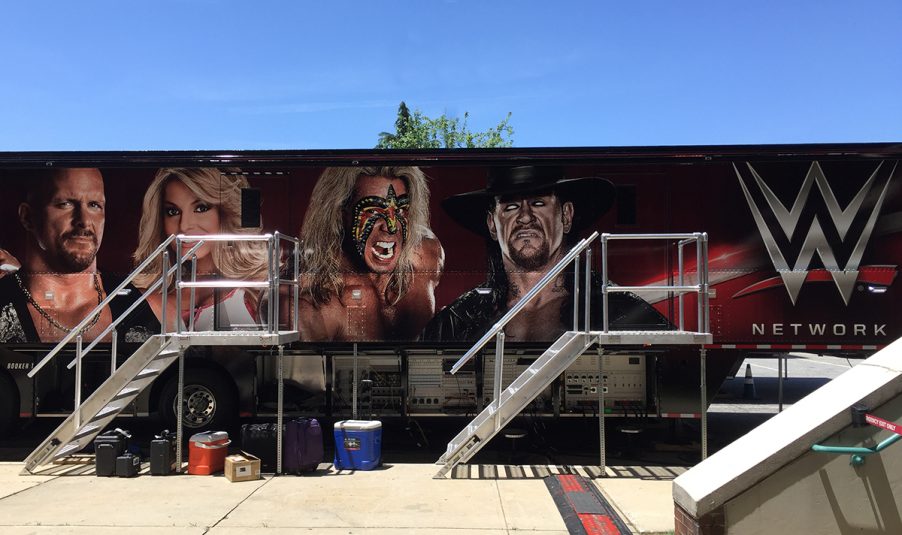 The launch of the trucks also marks WWE’s transition to a totally tapeless workflow, a transition that is not always easy for an entertainment show.
The launch of the trucks also marks WWE’s transition to a totally tapeless workflow, a transition that is not always easy for an entertainment show.
“The move from tape to tapeless was a process,” says Levine, “and a joint venture between the guys in the field, our integration department, and their organization in Stamford. But that workflow is totally new to them and somewhat unique to an entertainment-style client,” which typically records an event to drives and then edits at home.
The trucks fiber KVM infrastructure uses a Thinklogical VX 320V 320-port video and KVM matrix switch at the core and Thinklogical Velocity KVM extenders at the workstations running at 6.25 Gbps uncompressed video and KVM signal transmission bandwidth – meaning there is no loss of resolution so the controls they use are precise and exact in their motions with no latency or jitter in the movements. The Thinklogical KVM gives operators “any-to-any” access to, and control of, the slow motion and instant replay systems, the graphics systems, and other functions anywhere in the truck. The WWE truck engineers can with the push of a button assign any function or operation to any workstation in any of the truck units, providing maximum flexibility to meet production needs as required.
A Thinklogical TRANSplex system connects the trucks using CWDM (coarse wavelength division multiplexing) technology, which allows multiple high-bandwidth video, KVM and other signals to be transmitted over less fiber – often requiring a single cable (significantly reducing the amount of cables needed to connect the truck units and shortening setup and strike time).
An Expanded Footprint, Increased Tech Firepower
The A unit features a similar but slightly larger control room to Red and Black, a significantly expanded graphics area (featuring Ross Video Xpression graphics), recording, video, and EIC engineering. The B unit houses the four audio rooms, the second control room, space for several flex positions, an A2 audio area, and dedicated workstations for media management and IT.
“We’ve allowed for a much more potent integration with our IT team to help us manage the workflow, and part of that was a large workspace in WWE 2 to accommodate IT,” says Leslie. “It’s really upped the ante in terms of IT’s involvement in the day-to-day operation of the truck. It’s more of a melding of one team than it is standalone islands of expertise.”
Increasingly incorporating slow-motion replay elements into telecasts, WWE opted to significantly expand the replay room, which features seven EVS XT3 servers totaling 84 channels. In addition, four EVS IPDirectors schedule 28 record streams and control 18 channels of on-air and screen playback elements. Three EVS XTAccess systems operate 38 streams to 96 external terabytes daily delivered to central ingest. On the ENG side, an XFile3 restores Sony SxS ENG cards 10 times faster than real time, enabling all ENG crews to deliver their packages to air faster.
The trucks’ four audio rooms handle, respectively, main mix, submix, preshow mix (working with the secondary control room), and international feed. The rooms are built around a Calrec Artemis console, two Calrec Apollo consoles, and a DiGiCo SD10B, respectively.
“With two double expandos and the C unit, we’re reinventing every arena we go to with new parking scenarios,” says Leslie. “Red and Black were expandos, but they weren’t true double expandos. So the size of these new units is a big advantage for us. All the audio rooms and second production suite, which isn’t much smaller than the main production suite, also allow concurrent program capture, which we can utilize at pay-per-views and other places. The production team has been extremely appreciative of the added workspace.”
